Snow Precipitation Measured by Gauges: Systematic Error Estimation and Data Series Correction in the Central Italian Alps
Abstract
:1. Introduction
2. Case Study and the Error Estimate
3. Correction of Precipitation Data
- 90% of snow-only events occur in days with average temperature below 1.5 °C
- 90% of rain-only events occur in days with average temperature above 0.1 °C
- 90% of sleet events occur in days with average temperature between −3.1 °C and 4.8 °C
4. Discussion
- if daily wind speed V is < 1.5 m/s, then Cs,w = 0.4 (S. Caterina, Aprica Magnolta)
- if 1.5 < V < 2.5 m/s, then Cs,w = 0.7 (Cancano P3)
- if V > 2.5, then Cs,w = 1.5 (Cancano P4)
5. Conclusions
Acknowledgments
Author Contributions
Conflicts of Interest
References
- Sevruk, B. Point precipitation measurement: Why are they not corrected? In Water for the Future: Hydrology in Perspective; IAHS Publication: Rome, Italy, 1987. [Google Scholar]
- Immerzeel, W.; Wanders, N.; Lutz, A.; Shea, J.; Bierkens, M. Reconciling high altitude precipitation in the upper Indus basin with glacier mass balances and runoff. Hydrol. Erath Syst. Sci. 2015, 19, 4673–4687. [Google Scholar] [CrossRef]
- Groot Zwaaftink, C.D.; Cagnati, A.; Crepaz, A.; Fierz, C.; Macelloni, G.; Valt, M.; Lehning, M. Event-driven deposition of snow on the Antarctic Plateau: Analyzing field measurements with SNOWPACK. Cryosphere 2013, 7, 333–347. [Google Scholar] [CrossRef]
- Sevruk, B.; Hertig, J.; Spiess, R. Wind field deformation above precipitation gauge orifices. IAHS 1989, 179, 65–70. [Google Scholar]
- Chvila, B.; Ondras, M.; Sevruk, B. The wind-induced loss of precipitation measurement of small time intervals as recorded in the field. In Proceedings of the WMO/CIMO Technical Conference, Bratislava, Slovaki, 25 September–3 October 2002. [Google Scholar]
- Rasmussen, R.; Baker, B.; Kochendorfer, J.; Meyers, T.; Landolt, S.; Fischer, A.; Black, J.; Theriault, J.; Kucera, P.; Gochis, D.; et al. How well are we measuring snow? The NOAA/FAA/NCAR winter precipitation test bed. BAMS 2012, 6, 811–829. [Google Scholar] [CrossRef]
- Duchon, C.; Cole, J.; Rasmussen, R. Measuring heavy snowfall using five different windshields and vibrating-wire precipitation gauges. In Proceedings of the 65th Eastern Snow Conference, Lake Morey, Fairlee, VT, USA, 28–30 May 2008. [Google Scholar]
- Pan, X.; Yang, D.; Li, Y.; Barr, A.; Helgason, W.; Hayashi, M.; Marsh, P.; Janowicz, J.P.R. Bias Corrections of Precipitation Measurements across Experimental Sites in Different Ecoclimatic Regions of Western Canada. Cryosphere Discussi. 2016, 10, 2347. [Google Scholar] [CrossRef]
- Sevruk, B. Distribution of precipitation in mountainous areas. In Evaporation Losses from Storage Gauges; WMO: Geneva, Switzerland, 1972; pp. 96–102. [Google Scholar]
- Nitu, R.; Wong, K. CIMO Survey on National Summaries of Methods and Instruments for Solid Precipitation Measurement at Automatic Weather Stations; WMO: Geneva, Switzerland, 2010. [Google Scholar]
- Sevruk, B. Correction of measured precipitation in the Alps using the water equivalent of new snow. Nord. Hydrol. 1983, 1, 49–58. [Google Scholar]
- Savina, M.; Schaeppi, B.; Molnar, P.; Burlando, P.; Sevruk, B. Comparison of a tipping-bucket and electronic weighing precipitation gage for sbnowfall. Atmos. Res. 2012, 103, 45–51. [Google Scholar] [CrossRef]
- Nitu, R.; Rasmussen, R.; Baker, B.; Lanzinger, E.; Joe, P.; Yang, D.; Smith, C.; Roulet, Y.; Goodison, B.; Liang, H.; et al. WMO Intercomparison of Instruments and Methods for the Measurement of Solid Precipitation and Snow on the Ground: Organization of the Experiment; WMO: Geneva, Switzerland, 2012. [Google Scholar]
- Cagnati, A.; Crepaz, A.; Macelloni, G.; Pampaloni, P.; Ranzi, R.; Tedesco, M.; Tomirotti, M.; Valt, M. Study of the snow meltfreeze cycle using multi-sensor data and snow modelling. J. Glaciol. 2004, 50, 419–426. [Google Scholar] [CrossRef]
- Bocchiola, D.; Rosso, R. The distribution of daily snow water equivalent in the central Italian Alps. Adv.Water Resour. 2007, 30, 135–147. [Google Scholar] [CrossRef]
- Sevruk, B. Conversion of Snowfall Depths to Water Equivalents in the Swiss Alps. Zürcher Geogr. Schr. 1986, 23, 13–23. [Google Scholar]
- Serreze, M.C.; Clark, M.P.; Armstrong, R.L.; McGinnis, D.A.; Pulwarty, R.S. Characteristics of the western United States snowpack from snowpack telemetry (SNOTEL) data. Water Resour. Res. 1999, 35, 2145–2160. [Google Scholar] [CrossRef]
- Cagnati, A. Strumenti di Misura e Metodi di Osservazione Nivometeorologici; AINEVA: Trento, Italy, 2003. (In Italian) [Google Scholar]
- Valt, M.; Cagnati, A.; Corso, T. Stima dell’equivalente in acqua della neve. Neve e Valanghe 2006, 59, 24–33. (In Italian) [Google Scholar]
- Valt, M.; Moro, M. Average snowcover density values in eastern Alps mountain. Proceedings of EGU General Assembly 2009, Vienna, Austria, 19–24 April 2009. [Google Scholar]
- D’Aosta, A.V. Secondo Interconfronto SWE; ARPA: Valle d’Aosta, Aosta, Italy, 2016. [Google Scholar]
- Proksch, M.; Rutter, N.; Fierz, C.; Schneebeli, M. Intercomparison of snow density measurements: Bias, precision, and vertical resolution. Cryosphere 2016, 10, 371–384. [Google Scholar] [CrossRef]
- Valgoi, P. Cuscinetto per la misura della densità della neve (snow pillow). Neve e Valanghe 2011, 72, 48–53. (In Italian) [Google Scholar]
- Goodison, B.; Louie, P.; Yang, D. WMO Solid Precipitation Measurement Intercomparison-Final Report; WMO: Geneva, Switzerland, 1998. [Google Scholar]
- Sevruk, B. Adjustment of tipping-bucket precipitation gauge measurements. Atmos. Res. 1996, 42, 237–246. [Google Scholar] [CrossRef]
- ArCIS-Gruppo di lavoro Archivio climatologico dell’Italia centro-settentrionale. Il clima nell’inverno 2013–2014: Le eccezionali anomalie climatiche del Centro-Nord Italia. Neve e Valanghe 2014, 81, 4–9. (In Italian) [Google Scholar]
- Colli, M.; Lanza, L.; Rasmussen, R.; Thériault, J. The collection efficiency of shielded and unshielded precipitation gauges. Part I: CFD airflow modeling. J. Hydrometeorol. 2016, 17, 231–243. [Google Scholar] [CrossRef]
- Colli, M.; Lanza, L.; Rasmussen, R.; Thériault, J. The collection efficiency of shielded and unshielded precipitation gauges. Part II: Modeling particle trajectories. J. Hydrometeorol. 2016, 17, 245–255. [Google Scholar] [CrossRef]
- Smith, C. Correcting the wind bias in snowfall measurements made with a Geonor T-200B precipitation gauge and alter wind shield. In Proceedings of the 15th Symposium on Meteorological Observation and Instrumentation, Atlanta, GA, USA, 17–21 January 2010. [Google Scholar]
- Macdonald, J.; Pomeroy, J. Gauge undercatch of two common snowfall gauges in a prairie environment. In Proceedings of the 64th Eastern Snow Conference, St. John’s, NL, Canada, 29 May–1 June 2007. [Google Scholar]
- Ranzi, R.; Grossi, G.; Bacchi, B. Ten years of monitoring areal snowpack in the Southern Alps using NOAA-AVHRR imagery, ground measurements and hydrological data. Hydrolog. Process. 1999, 13, 2079–2095. [Google Scholar] [CrossRef]
- Zweifel, A.; Sevruk, B. Comparative accuracy of solid precipitation measurement using heated recording gauges in the Alps. In Workshop on Determination of Solid Precipitation in Cold Climate Regions; Fairbanks: Zürich, Switzerland, 2002. [Google Scholar]
- Savina, M.; Schaeppi, B.; Molnar, P.; Burlando, P.; Sevruk, B. Comparison of a tipping-bucket and electronic weighing precipitation gage for snowfall. Atmos. Res. 2012, 103, 45–51. [Google Scholar] [CrossRef]
- Cugerone, K.; Allamano, P.; Salandin, A.; Barbero, S. Stima della precipitazione in siti di alta quota. Neve e Valanghe 2012, 77, 36–43. (In Italian) [Google Scholar]
- Eccel, E.; Cau, P.; Ranzi, R. Data reconstruction and homogenization for reducing uncertainties in high-resolution climate analysis in Alpine regions. Theor. Appl. Climatol. 2012, 110, 345–358. [Google Scholar] [CrossRef]
- Ranzi, R.; Grossi, G.; Gitti, A.; Taschner, S. Energy and mass balance of the Mandrone Glacier. Geogr. Fis. Din. Quat. 2010, 33, 45–60. [Google Scholar]
- Grossi, G.; Caronna, P.; Ranzi, R. Hydrologic vulnerability to climate change of the Mandrone glacier (Adamello-Presanella group, Italian Alps). Adv. Water Resour. 2013, 55, 190–203. [Google Scholar] [CrossRef]
- World Meteorlolgical Organization. Intercomparison of Models of Snowmelt Runoff; WMO Operational Hydrology Report No 23, WMO Publ. No 646; WMO: Geneva, Switzerland, 1986. [Google Scholar]
- Kienzle, S. A new temperature based method to separate rain and snow. Hydrol. Process. 2008, 22, 5067–5085. [Google Scholar] [CrossRef]
- Forland, E.; Allerup, P.; Dahlström, B.; Elomaa, E.T.; Perälä, J.; Rissanen, P.; Vedin, H.; Vejen, F. Manual for operational correction of Nordic precipitation data. DNMI Oslo 1996, 96, 66. [Google Scholar]
- Morin, S.; Lejeune, Y.; Lesaffre, B.; Panel, J.; Poncet, D.; David, P.; Sudul, M. An 18-yr long (1993–2011) snow and meteorological dataset from a mid-altitude mountain site (Col de Porte, France, 1325 m alt.) for driving and evaluating snowpack models. Earth Syst. Sci. Data 2012, 4, 13–21. [Google Scholar] [CrossRef]
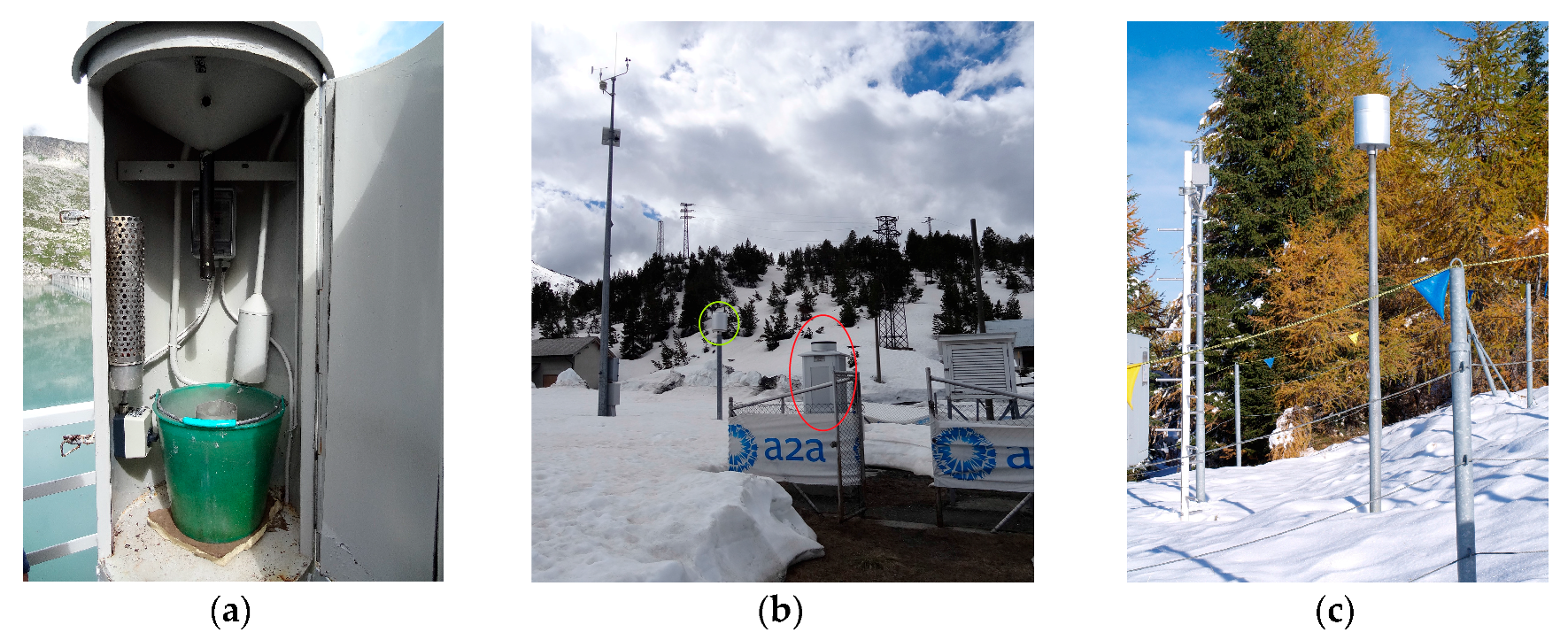

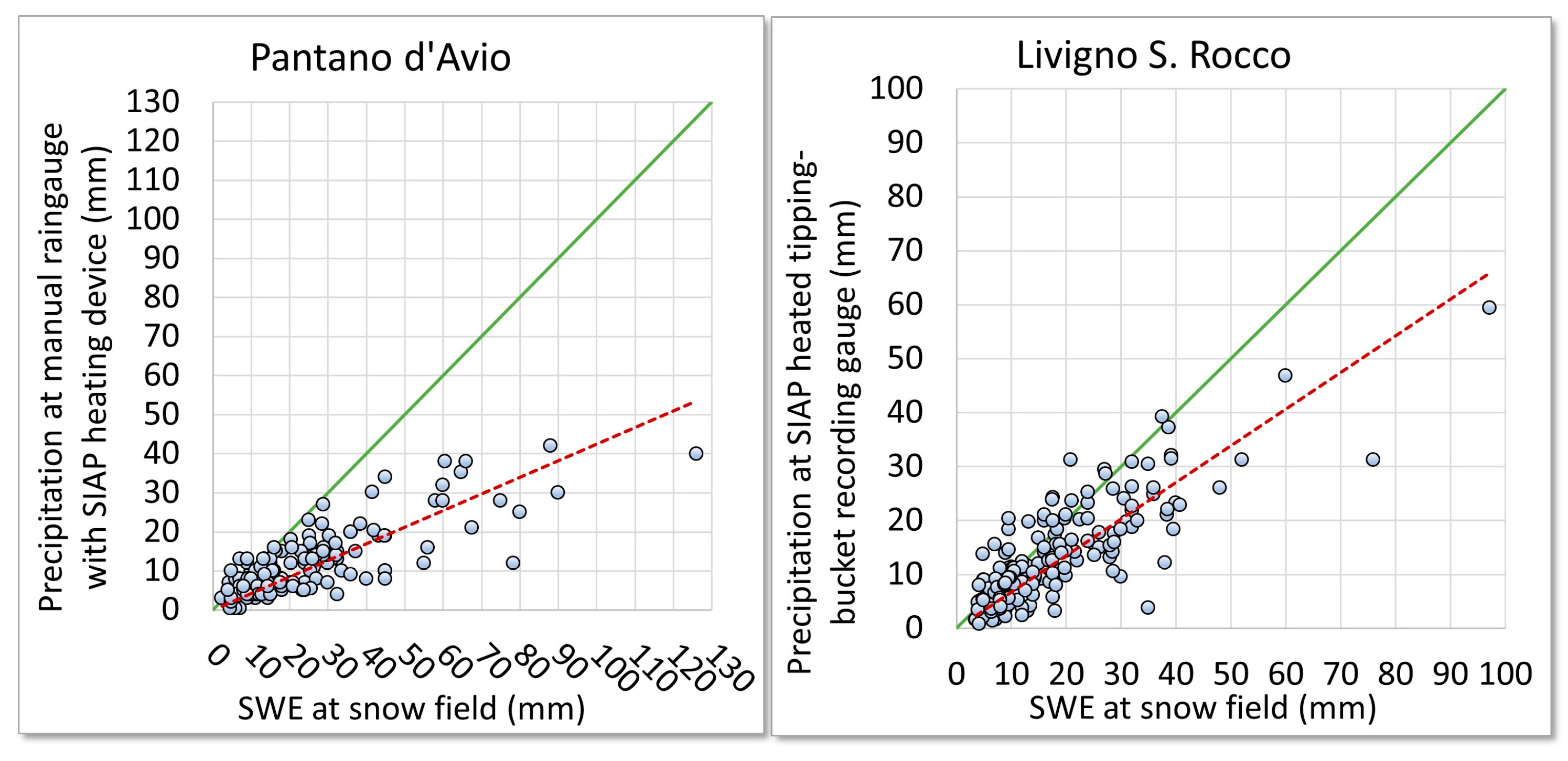
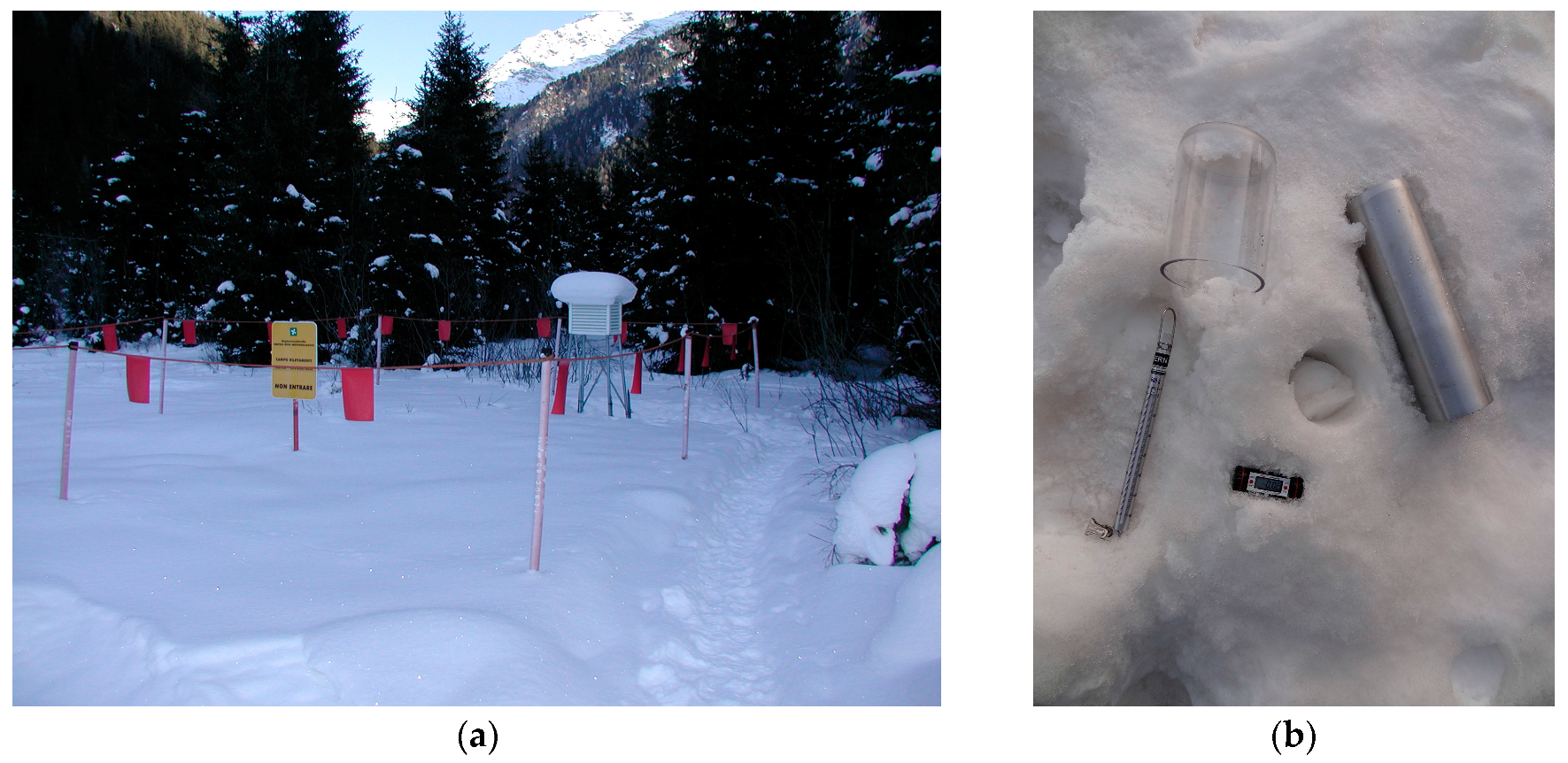
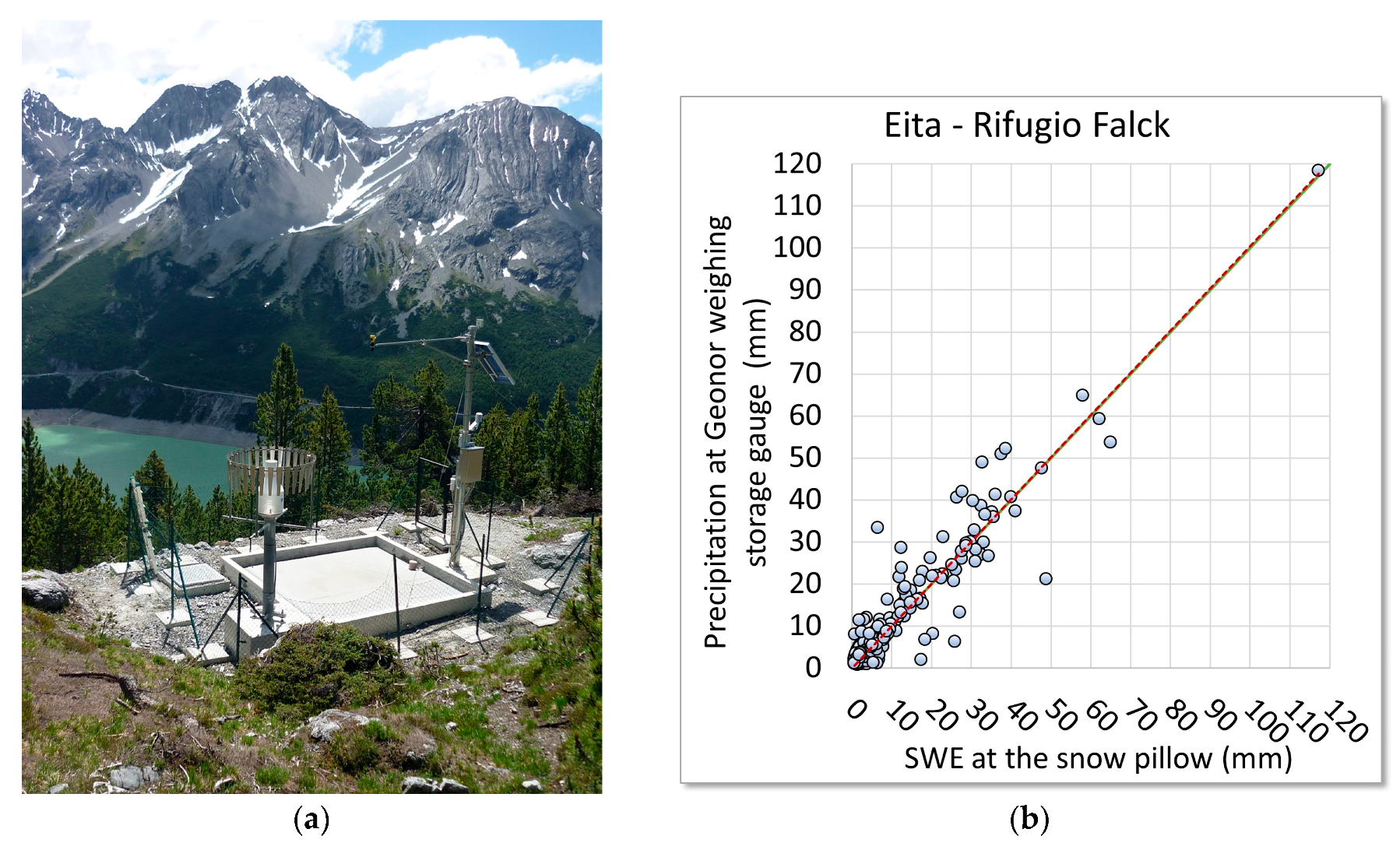
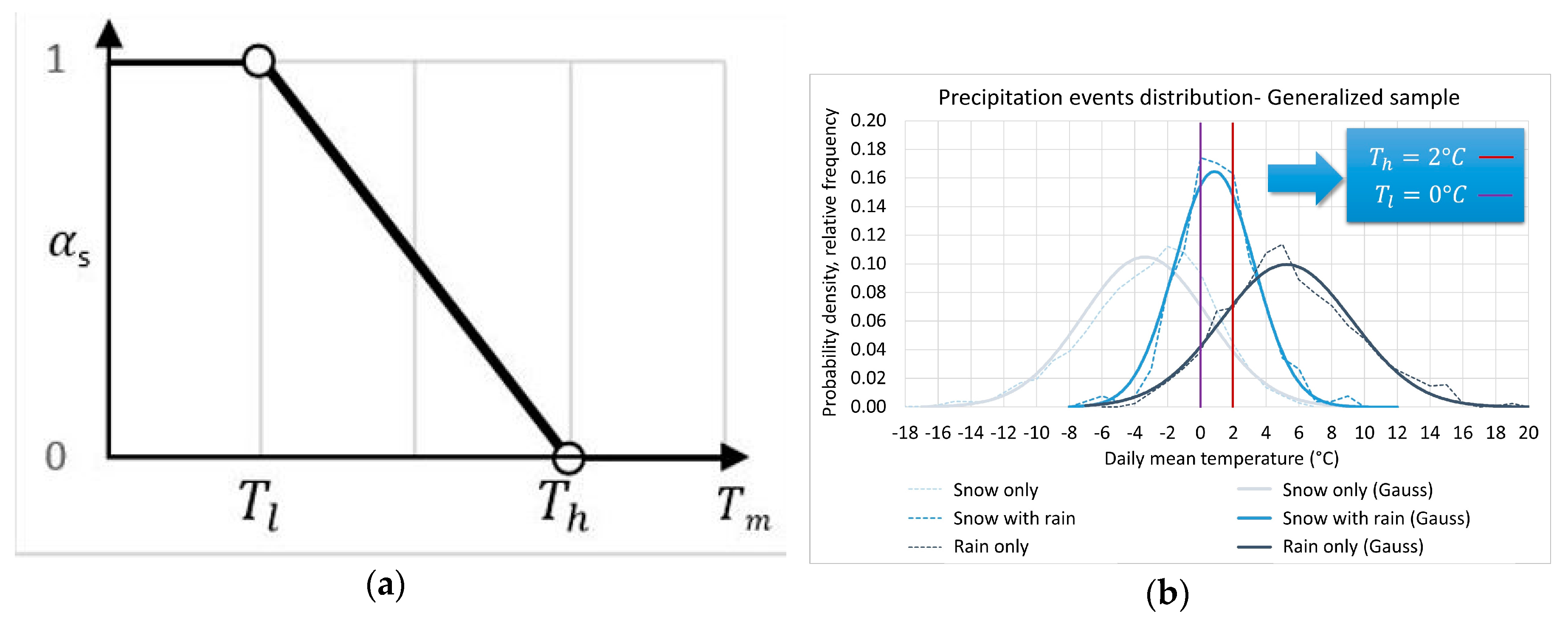
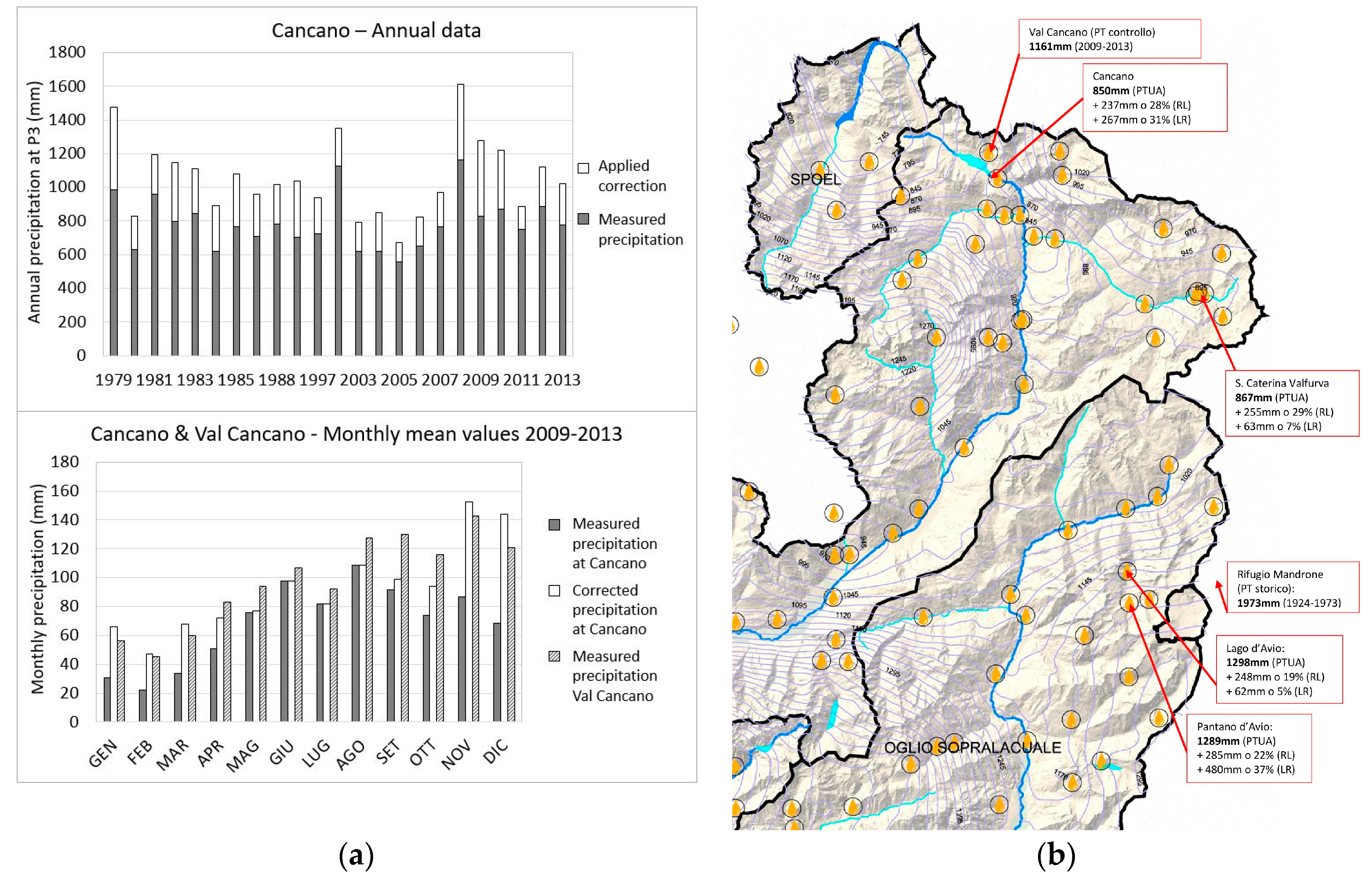
| Sites | Position WGS84 (Lat; Long) | Elevation (m a.s.l.) | Period | Wind Exposure | Wind Data Availability | Site Context | Instruments Compared | Distance SWE/SP-Px (m) | No. of Compared Measurements | Accumulated SWE (mm) | Accumulated P (mm) | Bias (%) |
|---|---|---|---|---|---|---|---|---|---|---|---|---|
| S. Caterina Valfurva | 46.410; 10.500 46.413; 10.493 | 1740 | 2001–2014 | Low | 2005–2010 | Valley, open | SWE-P3 | 590 | 75 | 866 | 649 | −25 |
| 2003–2010 | SWE-P4 | 28 | 359 | 177 | −51 | |||||||
| Livigno S. Rocco | 46.522; 10.125 | 1865 | 1989–2014 | Low | none | Valley, open | SWE-P3 | 0 | 241 | 3641 | 2662 | −27 |
| Cancano | 46.514; 10.317 46.513; 10.318 | 1950 | 1989–2013 | High | 2005–2010 | Valley, open | SWE-P3 | 120 | 301 | 5723 | 2353 | −59 |
| 2003–2010 | SWE-P4 | 73 | 1579 | 535 | −66 | |||||||
| Aprica | 46.154; 10.147 | 1180 | 1993–2014 | Low | none | Valley, garden | SWE-P1 | 0 | 66 | 1452 | 912 | −37 |
| Aprica Magnolta | 46.132; 10.140 46.129; 10.148 | 1865–1950 | 2009–2014 | Low | 2012–2014 | Slope, forest | SWE-P4 | 740 | 38 | 744 | 631 | −15 |
| Lago d’Arno | 46.048; 10.430 | 1830 | 1984–2014 | Medium | none | Slope, open | SWE-P2 | 0 | 163 | 3429 | 2597 | −24 |
| Pantano d’Avio | 46.167; 10.474 | 2390 | 1987–2014 | High | none | Slope, open | SWE-P2 | 20 | 176 | 3956 | 1909 | −52 |
| Lago d’Avio | 46.202; 10.474 | 1902 | 2003–2012 | Low | none | Valley, open | SWE-P1 | 0 | 12 | 220 | 176 | −20 |
| Eita | 46.388; 10.258 | 1950 | 2008–2014 | Medium | none | Valley, open | SP-PT | 0 | 195 | 2405 | 2554 | 6 |
| Malghera | 46.344; 10.142 | 1995 | 2008–2014 | Medium | none | Valley, open | SP-PT | 0 | 164 | 1835 | 1806 | −2 |
| Val Cancano | 46.532; 10.313 | 2190 | 2008–2014 | High | none | Slope, open | SP-PT | 0 | 254 | 2113 | 2294 | 9 |
| Sites | Elevation (m a.s.l.) | Period | Instruments | No. of Measurements | Accumulated SWE (mm) | Accumulated P (mm) | Bias (%) |
|---|---|---|---|---|---|---|---|
| Eita | 1950 | 2008–2014 | SP-PT | 195 | 2405.4 | 2554.3 | 6 |
| Malghera | 1995 | 2008–2014 | SP-PT | 164 | 1835.0 | 1805.7 | −2 |
| Val Cancano | 2190 | 2008–2014 | SP-PT | 254 | 2112.7 | 2294.3 | 9 |
| Sites | Elevation (m a.s.l.) | Distance (m) | Instruments | No. of Measurements | Correction Factor Cs | New Bias (%) | Errors St. Dev (mm) |
|---|---|---|---|---|---|---|---|
| S. Caterina Valfurva | 1740 | 590 | SWE-P3 | 75 | 0.30 | −3.6 | 4.9 |
| SWE-P4 | 28 | 0.80 | −11.8 | 4.3 | |||
| Livigno-S. Rocco | 1865 | 0 | SWE-P3 | 241 | 0.35 | −2.6 | 6.6 |
| Cancano | 1950 | 120 | SWE-P3 | 301 | 1.15 | −17.0 | 13.1 |
| SWE-P4 | 73 | 1.50 | −17.7 | 10.9 | |||
| Aprica | 1180 | 0 | SWE-P1 | 66 | 0.60 | −4.7 | 13.4 |
| Aprica-Magnolta | 1865/1950 | 740 | SWE-P4 | 38 | 0.11 | −6.1 | 5.8 |
| Lago d’Arno | 1830 | 0 | SWE-P2 | 163 | 0.25 | −6.9 | 10.7 |
| Pantano d’Avio | 2390 | 20 | SWE-P2 | 176 | 1.05 | −2.3 | 11.5 |
| Lago d’Avio | 1902 | 0 | SWE-P1 | 12 | 0.20 | −3.6 | 13.9 |
| Sites | No. of years | Cs | Pm (mm) | Pm,c (mm) | Error ΔP (%) |
|---|---|---|---|---|---|
| S. Caterina Valfurva | 40 | 0.3 | 860.3 | 923.6 | 7% |
| Cancano | 23 | 1.15 | 788.3 | 1055.5 | 34% |
| Pantano d’Avio | 3 | 1.05 | 1417.3 | 1897.0 | 34% |
| Lago d’Avio | 12 | 0.2 | 1263.3 | 1324.8 | 5% |
| Sites | Instrument | Number of Measurements | Accumulated SWE (mm) | Accumulated Measured Precipitation P (mm) | Corrected Precipitation Pc (mm) | Error St. Dev (mm) | Event Average Wind Speed (m/s) | Annual Average Wind Speed (m/s) |
|---|---|---|---|---|---|---|---|---|
| SCP/S.Caterina Valfurva | SWE-P3 | 26 | 337.8 | 256.2 | 387.0 | 4.5 | 0.7 | 1.1 (2005–2009) |
| SWE-P4 | 26 | 337.8 | 170.2 | 264.6 | 3.3 | |||
| CAN/Cancano | SWE-P3 | 82 | 1758.3 | 650.4 | 1354.4 | 13.4 | 2.3 | 2.6 (2005–2009) |
| SWE-P4 | 71 | 1566.8 | 530.0 | 1106.1 | 9.7 | |||
| AMA/Aprica Magnolta | SWE-P4 | 37 | 694.6 | 595.4 | 991.9 | 13.4 | 1.1 | 2.2 (2012–2014) |
© 2017 by the authors. Licensee MDPI, Basel, Switzerland. This article is an open access article distributed under the terms and conditions of the Creative Commons Attribution (CC BY) license (http://creativecommons.org/licenses/by/4.0/).
Share and Cite
Grossi, G.; Lendvai, A.; Peretti, G.; Ranzi, R. Snow Precipitation Measured by Gauges: Systematic Error Estimation and Data Series Correction in the Central Italian Alps. Water 2017, 9, 461. https://doi.org/10.3390/w9070461
Grossi G, Lendvai A, Peretti G, Ranzi R. Snow Precipitation Measured by Gauges: Systematic Error Estimation and Data Series Correction in the Central Italian Alps. Water. 2017; 9(7):461. https://doi.org/10.3390/w9070461
Chicago/Turabian StyleGrossi, Giovanna, Amerigo Lendvai, Giovanni Peretti, and Roberto Ranzi. 2017. "Snow Precipitation Measured by Gauges: Systematic Error Estimation and Data Series Correction in the Central Italian Alps" Water 9, no. 7: 461. https://doi.org/10.3390/w9070461






